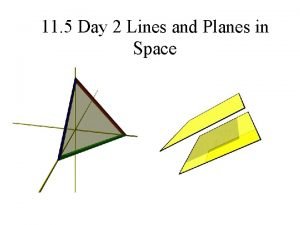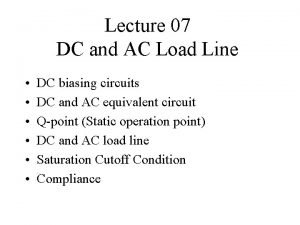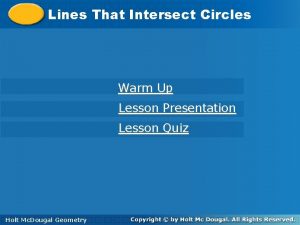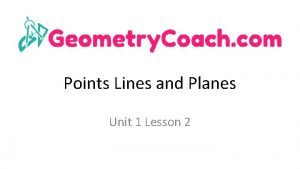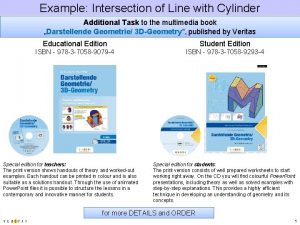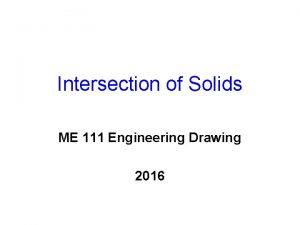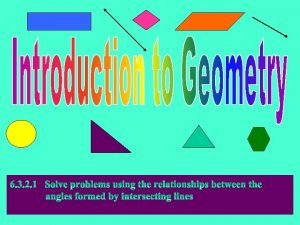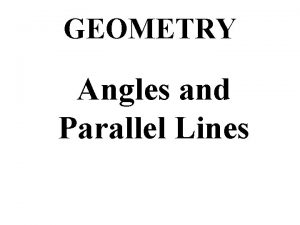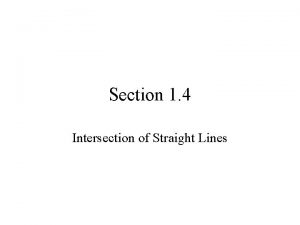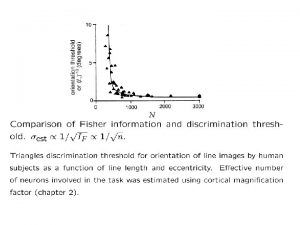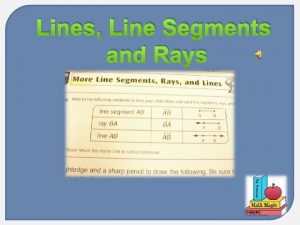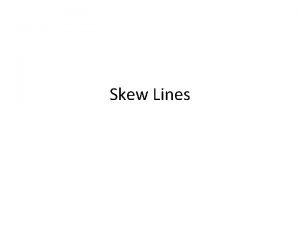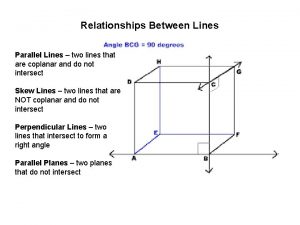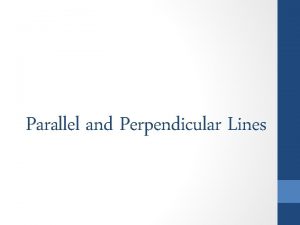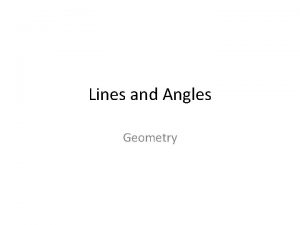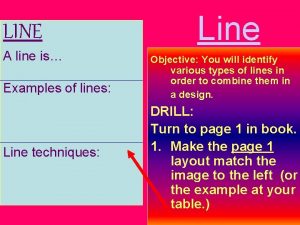Overview Intersection of two train lines Each line











- Slides: 11

Overview: Intersection of two train lines. Each line has two directions where one train travels above the tracks in one direction while the other travels below the tracks in the opposite direction. Hence the station has two levels. Passengers can switch between the two lines via stairs connecting upper and lower floors 1

Issue: minimize the time required to spend at each stop & maximize comfort and ease of entry and exit Solution: - Height differential (red arrow) between platform and floor of the train allows for quicker and easier exit with less vertical movement needed to sit down and stand up (resembling the entry and exit to to/from an SUV. In order to reduce the entry and exit time, the floor of the train is elevated above the platform of station. Given the height of the train floor above the station floor there is a reduction in the standing up and sitting down time and effort required for each passenger. The differential in height of vehicle platform versus ground level makes for easy access, similar to seating into and getting out from an SUV or a golf cart. The image below is from various videos showing that for an older person it takes less than 3 seconds to exit or enter vehicle. Given this preliminary test, and at one passenger per row with a maximum of 3 seconds required for entry and 3 seconds for exit, a stop is not expected to exceed 6 seconds, thus an average of 8 to 10 seconds stop time per station may be a reasonable assumption.

Users of the system: public at large including wheelchair access Because the train is only 48” wide, wheelchair users will need to follow the yellow arrow if the wheelchair depth is greater than the width of the train

Issue : depth when entering with a wheelchair is less than code – but at a minimum acceptable of 48” “when circumstances prevent compliance. As a way to compensate the wheel chair can turn 90 degrees so it has ample space – 72” lengthwise – as shown by the red dotted line/arrows ADA CODE: 4. 10. 9 – Floor Plan of Elevator Cars The floor area of elevator cars shall provide space for wheelchair users to enter the car, maneuver within reach of the controls, and exit from the car. Acceptable door opening dimensions shall be 36″ (915 mm) minimum. Cab depth shall be 51″ (1291 mm) minimum with a 54″ (1370 mm) minimum from rear of cab to inside face of door. Cab width shall be a minimum of 68″ (1730 mm) for side opening doors and an 80″ (2030 mm) minimum for center opening doors. When existing circumstances prevent compliance with cab dimensions it must be noted that no dimensions shall be less than 48″ by 48″

How the space will positively influence the Health, Safety and Wellness for occupants. Noise Free - the c. Train wheels use rubber on the area of contact with the tracks which combined with small electric motors produce no audible noise from street level. Privacy - Each passenger has a dedicated cabin with sufficient space for suitcases and also the option to share with a significant other. Comfort - Seating for all – the c. Train provides seating room only Low stress - access to seats – the c. Train model is design to cover all major streets and avenues at sufficient capacity to accommodate the demand without the need for passengers to compete for seats. Easy Access to mass transit from all areas - the c. Train concept is designed to cover all areas in a city with stations within 2 -3 blocks from any residence or business. This reduces the dependence on cars and adverse health effects of pollution and stress from traffic. Visually pleasing - open views with abundant light

• Biophilic design • Temperatures - for stations in climates where there is need for enclosure there will be elements such as Thermal Airflow with variability between 64 and 70 degrees Fahrenheit, • Vegetation – inclusion of natural elements such as plants helps induce relaxation, and in this case would help reduce the sense of an artificial environment relative to the typical spaces people are used to. On the first floor vegetation can serve also as a separators from structural elements (such as the supporting arches) and area below stairs. On the right side the arches are separated by glass versus vegetation on the right side. 6

Key elements implemented from Environment and Behavior Theories • Biophilic design • Water – Presence of flowing water enhances well being. 7

The system will have a wide spectrum of users including those with neurological disorders impacting the relationship of the occupant to the environment in a variety of ways such as perceiving distances, colors, orientation, ability to walk, grasp, as well as their sense of self, of independence. • Points of access between floors, have arches with Exit/Entry signs at the top for easy wayfinding • Use of curvilinear shapes to inspire femininity, nurturing, harmony and warmth – as a way to compensate for the sense of the station being a new imposition upon the visual landscape. The round shapes also can ameliorate the potential of heights and the sense of the station being suspended above traffic, particularly because of wide usage of transparent materials • Circulation optimized for spatial progression, appropriate signage, combined with appropriate color contrast.

CIRCULATION LEVEL 1 Passenger exiting a train has three options A – Switch to a train on the same level B – Switch to a train on the other level C – exit the station via the stairs or the elevators Sidewalk LEVEL 2 Entry steps LEVEL 1 Passengers Entering to LEVEL 2 Passengers Entering to LEVEL 1 WALKWAY TO LEVEL 1 Entry steps LEVEL 2 Landing Steps to/from LEVEL 2 ELEVATOR Train C B A Steps to/from LEVEL 2 rm o f t Pl. Ba C z Train Exit STEPS LEVEL 2 WALKWAY from LEVEL 1 Landing Exit STEPS LEVEL 1 Sidewalk Passengers exiting from LEVEL 2 Passengers exiting from LEVEL 1 Passengers switching to a train on the same level Passengers changing to a train on the other level

Entry to LEVEL TWO Entry to LEVEL ONE Boarding/ onboarding area Elevator Exit from LEVEL TWO Exit from LEVEL ONE Boarding / onboarding area

Visual Impact: One of the main challenges with overhead transportation is the visual impact on the urban landscape. To minimize the visual impact the c. Train has the following features - Transparent materials – maximizing the use of transparent materials for both the stations and the trains helps reduce visual impact. Research needed regarding the use of transparent materials combined with metallic skeletons for the supporting arches - Minimal width - only 48” wide - Minimal height – only sufficient height for a passenger to fit in seated position – similar to the height of an SUV - Minimal thickness of supporting structures - the above to features help minimize weight which in turn minimize thickness needed for the structure the support the tracks - c. Train travels above and below the same set of tracks in order to keep it as far away as possible from either side of the sidewalks (as shown by the two arrows)
 Intersection line between two planes
Intersection line between two planes Line of intersection of two planes formula
Line of intersection of two planes formula The point of intersection of dc and ac load line is called
The point of intersection of dc and ac load line is called Identify each line or segment that intersects each circle
Identify each line or segment that intersects each circle Name the intersection of line qz and segment wu
Name the intersection of line qz and segment wu Line cylinder intersection
Line cylinder intersection Chloe goldstein
Chloe goldstein Interpenetration of solids in engineering drawing pdf
Interpenetration of solids in engineering drawing pdf Intersection of two triangles
Intersection of two triangles Intersection of two geometric figures
Intersection of two geometric figures Line vw and line xy are parallel lines
Line vw and line xy are parallel lines Intersecting lines angles
Intersecting lines angles

